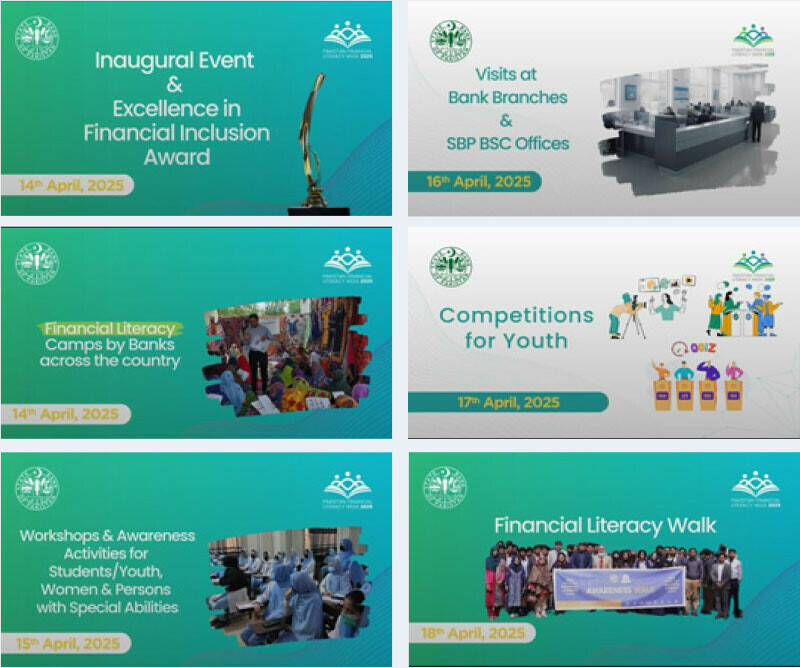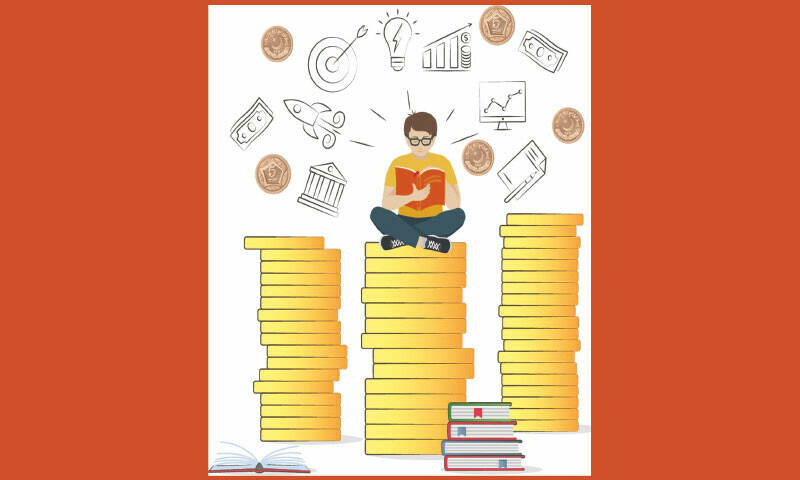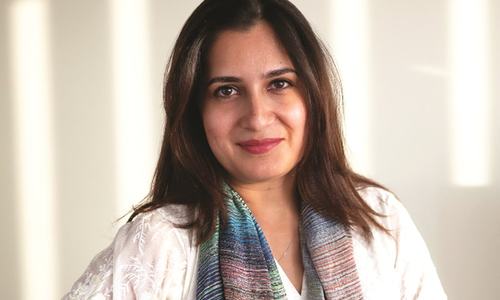A Step Forward Towards Financial Empowerment
In April 2025, the State Bank of Pakistan (SBP), in collaboration with key financial institutions, launched Pakistan Financial Literacy Week (PFLW) 2025. Held from April 14 to 18, this nationwide initiative aimed to promote financial literacy and inclusion across the country.
PFLW is a component of the SBP’s broader National Financial Literacy Programme launched in 2017 to educate low-income populations, with a particular focus on women, young people and children. Building on this foundation, the recently developed National Financial Education Roadmap 2025-29 aims to enhance knowledge and access to quality financial services for all segments of society, targeting 50 million beneficiaries. PFLW is one of the components of this roadmap, encompassing a multipronged outreach programme that includes one-on-one education and digital teaching methods such as gaming and app-based interfaces and more.
The success of PFLW 2025 illustrates the importance of collective efforts and technological advancements in expanding financial access and inclusion. Unlike previous years, where the SBP’s financial literacy initiatives were concentrated among banks and associated entities, this year, the entire financial sector united under one umbrella on lines similar to the Roshan Digital Account (RDA) initiative, with the aim to promote financial awareness, encourage savings and investments, enhance financial inclusion, and foster economic stability. The initiative sought to educate individuals about financial products and services, instilling the importance of saving and prudent investment. By bringing underserved populations into the formal financial system, PFLW’s goal was to empower citizens to make informed financial decisions, contributing to overall economic health.
The week commenced with a symbolic gong ceremony at the Pakistan Stock Exchange (PSX) Trading Hall, marking the start of a collaborative effort among key financial institutions. Led by the SBP and partnered with the Securities and Exchange Commission of Pakistan (SECP), capital market intermediary institutions such as PSX, the Central Depository Company (CDC), Pakistan Mercantile Exchange (PMEX), and the Mutual Funds Association of Pakistan (MUFAP) joined hands, bringing along with them asset management companies. The insurance sector was a prominent participant in PFLW.
Throughout the week, a diverse range of activities were conducted across schools, colleges, universities and communities nationwide. They included workshops, awareness sessions and digital campaigns designed to equip individuals with the knowledge and tools needed for informed financial decision-making. The week featured financial literacy camps in the major cities, including Karachi, Lahore, Islamabad and Peshawar in an effort to engage communities directly and make financial education accessible beyond traditional settings. These events drew thousands of participants from all walks of life, united under the cause of building a financially aware and empowered society.
Speaking to the financial education lead of one of the international banks in Pakistan, I learned that the SBP had created a WhatsApp group where stakeholders exchanged notes throughout the day and updated real-time activities. This was a collaborative approach that allowed participants to learn from each other’s experiences and adjust their programmes accordingly.
The banks worked alongside their staff members to impart awareness about the importance of financial inclusion, understanding banking products, and basic banking operations. There was an organised and concerted effort to cover all grounds. Banks organised camps, invited target beneficiaries to their branches nationwide and taught them the basic concepts of money management. Other entities educated participants about their respective offerings and products.
The insurance companies and capital market intermediaries focused on awareness about their offerings, ranging from mutual funds and equity investments to insurance coverage and their role in an individual’s portfolio. Notable contributors included:
–Mohsen Siddiq from Gen Mo, a financial education-focused company that collaborates with financial institutions to increase financial literacy and outreach. They work in the space of basic financial education, savings, investments and other finance concepts. They have an impressive digital education platform through games.
• Hissan Ur Rehman, an enthusiast in the space of investments and the economy. He was among the first to introduce a course on stock market investment basics at LUMS and has taught hundreds of people through six to eight week courses offered by PSX since 2022-23.
• Adeel Azhar, a banker turned RJ and influencer, has worked on financial education and increasing awareness for investment, capital market instruments and asset classes in his social causes.
• Sarmaaya Financials, established in 2019 by Laeeq Ahmad, is a leading platform dedicated to offering retail investors comprehensive and real-time solutions for tracking their investment portfolios. They have a unified app and web portal that simplifies the management of various investment types, including stocks, mutual funds, forex and commodities.
These collaborators organised various initiatives, working both independently and in tandem with banking institutions. The combined efforts of the financial sector, influencers and education partners made a significant impact, reaching a wide audience and promoting financial literacy.
Key findings from a broad review of the programme have brought to the fore the following considerations:
1. Relevance from the Target
Group’s Perspective
Some participants expressed
scepticism about the need for
financial literacy, citing economic
hardships and questioning the
necessity of saving or opening
a bank account. A few of the
comments included: “In times of
economic hardships, how do you
expect us to have anything to
save, let alone deposit or invest
money?”; “We hardly make ends
meet; how can we save?”; “Our
employers pay us in cash; why
do we need a bank account?”;
“All my vendors, from tailors to
shopkeepers, take cash; I don’t
need a bank account.”; and
“In our families, men manage
finances. Why do we need our
girls to learn these things?”
While the frustration expressed
is understandable, it was not
surprising given the current
economic situation. Nonetheless,
the attendance and interest in
learning continued throughout
the week, indicating a strong
potential for change.
2. Collaborative Approach
While leading the financial
literacy programme for the
Capital Market at PSX, I adopted
a strategy to collaborate with
strategic partners who could
serve as an extended team to
ensure scalability and impact.
Financial literacy experts,
fintechs, knowledge partners and
app owners working in similar
domains can be instrumental in
helping achieve the vision. The
SBP roadmap considers all this
and includes curriculum additions in the programme
scope. However, this may not
be sufficient to fill the huge
gap in the communities, and
given that not everyone is cut
out to be a good teacher, there
may be questions about the
effectiveness of classroom or
camp-based learning through
workshops and activities
delivered by people who may not
be equipped as teachers.
3. Salaried Classes Excluded
The salaried class, including
employees in the corporate
sector and SMEs, was not
included in the programme. Yet,
this segment is one of the most
productive in the economy and
often lacks the time to research
or think about investing. They are
also vulnerable to the effects of
inflation. Including this segment
in financial literacy programmes
is essential.
4. One Intensive Week Is
Not Enough
Although PFLW served as a
catalyst, a single week may not
suffice to instil lasting financial
habits. Continuous education
and reinforcement are essential
to bring about long-term
behavioural changes.
5. Curriculum Development
Financial education should be
part of the school and college
curriculum. It is a basic life skill
that should be taught along
with subjects like geography,
Pakistan studies, Urdu, science
and maths. Organising a week
or two of financial literacy across
the country during the year can
serve to amplify curriculum
based education.
6. Learning by Doing
To instil financial literacy, it
is essential to move beyond
theoretical knowledge and
engage individuals in practical
experiences. A pivotal
component of this strategy
involves encouraging individuals
to actively use financial
instruments. This includes
opening a savings account,
understanding debit and credit
transactions, interpreting bank
statements as a subject in
grade five or six and exploring
investment options such as
mutual funds and exchange
traded funds (ETFs) as these
pupils move to grades eight
and 10. By engaging in these
activities, they gain first-hand
experience and develop an
understanding of financial
concepts. Initiatives such as
young saver accounts, offered
by banks such as Bank AL
Habib, provide children with the
opportunity to open savings
accounts, a practice that
fosters early financial habits.
Introducing similar programmes
as early as grades three and
four can lay the foundation for
sound financial practices in
adulthood. This will be a leap in
terms of women’s empowerment
and financial independence as
young female students learn
banking and finance.
Financial literacy is not a challenge only for Pakistan. It is a global concern. Hence, the importance of the Sustainable Development Goals (SDGs). The SDGs four, five, 8, 10, 16 and 17 include financial independence and knowledge in some form or another. In fact, financial literacy is a cross-cutting enabler that supports the achievement of various SDGs. Here are some international examples.

• United States: Arizona Saves is a non-profit initiative that offers free financial education state-wide. It focuses on low- to moderate-income individuals and families and provides workshops, financial counselling and access to no-fee savings accounts. The Arizona Kids Saves programme uses age-appropriate curricula to teach financial principles to children, encouraging parents and children to discuss money management at home. Initiatives such as Investopedia’s Advisor Council contribute to enhancing financial literacy through expert insights and resources.
• Canada: Launched by credit unions, Humanomics is a programme aimed at improving financial wellbeing by raising awareness about financial literacy and offering innovative financial products that encourage healthy financial habits. Young people are a primary target audience, with initiatives like the Humanomics Youth Savings Account designed to reward positive savings behaviour.
• United Kingdom: Organisations like the Financial Literacy and Inclusion Campaign (FLIC) work to integrate financial education into schools, reaching millions of learners. MyBnk specialises in financial education for seven to 25-year-olds and provides workshops and microfinance schemes to teach money management and entrepreneurship. Financial Literacy and Inclusion Campaign (FLIC), a charity supporting financial literacy, reaches nearly 500 schools and over two million online learners. It aims to raise one million pounds to fund financial skills training for 10,000 students.
• Denmark: Money Week is an annual initiative facilitating over 600 visits to elementary schools across the country, where bank employees deliver two lessons on financial literacy. Schools are provided with online teaching materials to incorporate into their classes.
• Finland: Business Village is a programme where sixth-grade students engage in a simulated business environment to learn financial management, job application processes, and the importance of teamwork and decision making. Finland’s aim is to achieve the best financial literacy in the world by 2030.
• France: The EDUFI Strategy provides a national economic, budgetary, and financial education strategy based on the Organization for Economic Cooperation and Development’s (OECD) principles aimed at promoting financial literacy in French society. Measures include financial education and budget planning courses for young people, entrepreneurs, and financially vulnerable individuals. The Cité de l’Économie is a museum dedicated to fostering economic literacy in an instructive and entertaining way, funded by the Banque de France in cooperation with several partners, including the Ministry for Education.
• India: The Reserve Bank of India (RBI) has established over 1,500 financial literacy centres and conducts annual financial literacy weeks. Established with government support, these centres raise financial awareness through various schemes, including pension, insurance, and microfinance schemes. The government encourages saving habits, especially in rural regions.
• Jordan: The National Financial Education Programme (NFEP) is a compulsory curriculum for students in grades seven to 10, offering interactive financial literacy education and is part of Jordan’s National Financial Inclusion Strategy to improve financial literacy among young people.
• Malaysia: Buku Wang Saku (Pocket Money Book) was launched by Bank Negara Malaysia and uses illustrations to make financial education appealing to school-going children, teaching them about savings, conserving and avoiding wastage.
• Peru: School-based financial education involves 150 public schools, a 20-hour teacher training plan, and financial literacy classes for high school students. The programme has increased students’ financial knowledge and control, with added benefits of higher grades throughout the school curricula.
• Sri Lanka: The Central Bank of Sri Lanka launched the Financial Literacy Roadmap 2024-2028, aiming to enhance financial capabilities and inclusion.
These initiatives demonstrate a global commitment to enhancing financial literacy, equipping individuals with the knowledge and skills to make informed financial decisions.
Financial Literacy Week 2025 has marked a significant step towards enhancing financial awareness in Pakistan. However, to achieve a lasting impact, financial education must be an ongoing effort that is integrated into the national curriculum and supported by continuous programmes. By learning from international best practices and encouraging early savings habits, Pakistan can build a financially literate and resilient society.
The views expressed in this article are
those of the author and do not
necessarily reflect the official policy or
position of any institution or
organisation.
Raeda Latif is a senior marketing and
business strategist with extensive
experience in the financial sector.
raedalatif@gmail.com




Comments (0)